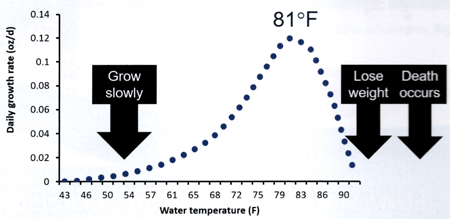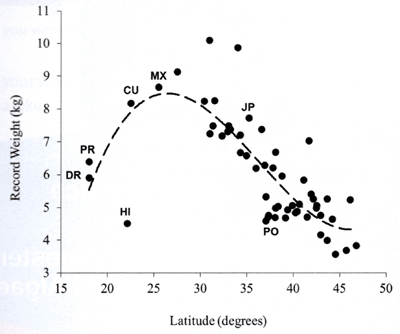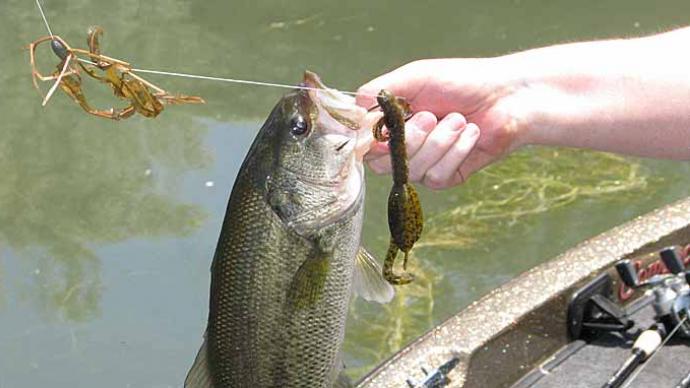
It is getting hot out there. Where I live, the summer temperatures soar into the mid-90s or higher and the humidity is downright oppressive. The surface water of local ponds feels like freshly run bath water, and on shore it feels like an oven. The only comfortable time to be around a pond is the early morning and late evening, so I spend the mid-day indoors in the modern comfort of central air conditioning.
But what about the poor fish? Are they suffering? Is it too hot for my bass? Like so many questions in pond management, there is no clear-cut answer. "Maybe" is the best I can offer. Let's dig deeper.
First, we need to think about the pond's thermal stratification. In the summer, the water is hottest at surface and it gets colder as you get deeper in the pond. You have felt this if you have been swimming in the pond - the surface is hot while your feet feel cooler. In the peak of summer, surface water temperatures in a deep pond can be in the low to mid-90s, but the deepest areas might still be in the upper-60s.
Bass can just go deeper, right? Not necessarily, as we must consider stratification of dissolved oxygen. Phytoplankton are releasing oxygen where photosynthesis is occurring. This is typically the upper 3 feet of the pond. There is not enough sunlight deeper in the pond to allow photosynthesis, so no oxygen production occurs. On the contrary, animal, plant, and bacterial respiration continue, using up oxygen. Thus, oxygen in deeper layers can drop to levels that are too low to support fish.
The result is that bass get squeezed between the hot surface and the oxygen-deficient depths. They try to find the goldilocks zone where it is not too hot but they can still breathe. Most of the time they are successful, but sometimes they get pushed into the hot water.
This is made worse by the fact that less oxygen can dissolve into water as it warms. The maximum amount of oxygen that can stay dissolved in water under normal conditions is called saturation, and saturation level is inversely related to temperature. For example, 60-degree water can hold about 10 mg/L of oxygen, while water in the low 90s can only hold about 7 mg/L. That's 30% less.
Next, we need to think about the biological effect of temperature. As temperature increases, more energy (and oxygen) is required for biological functions. For a coldblooded (poikilothermic) creature like a bass, warmer water means increased activity, more feeding, and faster growth, but only to a point (we'll discuss that next). This requires more oxygen. So as water gets hotter, bass need more and more of a resource that is becoming less and less available.
Bass have an optimum temperature for growth, which is about 81 degrees. As temperatures warm in the spring, bass growth rate increases (assuming there's food) and hits its highest point around 81 degrees. This is when they really pack on the pounds. When this optimum is exceeded in late- spring or early summer, grow rate drops off sharply. When temperatures get excessively hot (mid 90s), fish will lose weight. Bass will die when water temperature gets into the triple digits if they cannot find a cooler refuge (Figure 1).
As you can see, where the pond is located can be very important. If your pond is in North Dakota, the heat of summer is probably when your bass are growing the fastest. No need to worry about the water getting too hot, but you aren't likely to break the world record. To better understand this, think about where the biggest bass are caught. If you forget about California and Japan, which have unusual climates regulated by ocean currents, the biggest bass are typically caught within a few degrees' latitude of 30 degrees North latitude. George Perry caught the world record in an oxbow off the Ocmulgee River at a latitude between 31 and 32 degrees.

Of course, we all know that Florida is synonymous with big bass, but Florida suffers from this latitude effect. Bass maximum size decreases rapidly south of about 28 degrees North. Lake Okeechobee, which sits at the 27 degrees, is famous for big Florida bass but will likely never produce a world record bass. And it gets worse as you head further south. In fact, bass have been introduced into tropical lakes and reservoirs, and these systems underachieve in terms of maximum size (Figure 2). Part of this has to do with the lack of a cold water "reset" period and prolonged reproduction, but that is a topic for another day. Regardless, bass in tropical reservoirs with ideal year-round growing seasons don't live up to expectations.
What does this mean for the pondmeister in the deep South? Essentially, hot water likely results in bass losing weight during the peak of summer. It is rare for the heat to kill bass directly, but hot water holds little oxygen and biological oxygen demand is quite high, so it is common for oxygen kills to occur.
A solution to low oxygen is aeration. While surface aeration will ensure that there is an oxygenated refuge for fish when conditions get bad, it will generally not aerate the whole pond or destratify the pond's temperature and oxygen layering. Surface aerators are normally only used when a low oxygen situation arises. A fountain or other ornamental water feature rarely will provide significant aeration of surface waters, even when run continuously.
Destratification systems, or bottom plate diffuser-type aerators, will remove the pond's stratification and provide oxygen at greater depths when properly designed. These systems use rising columns of bubbles to lift cold bottom layers toward the surface, and oxygen diffuses from the rising bubbles and when water reaches the surface and contacts the air. The result is the relative homogenization of temperature throughout the water column, and to a lesser degree, oxygen.
A potential issue is that it is that these systems can increase the overall temperature of the water. When stratified, the surface layers protect the underlying cold water from heating. The top layer heats up, but the rest of the pond stays cool. When the water is continuously circulating, there is no insulation, and all water tends to warm towards the average air temperature. In mid-summer, this can be quite warm. Plus, there is direct solar heating, which is strongest around mid-day.
To combat this, some southern pond owners and managers have switched to nocturnal aeration only. A timer can be used to turn the system on at dark and off at dawn. This provides the benefits of aeration and destratification when air temperature is coolest but allows for temporary daytime stratification to form at the surface and help protect the thermal integrity of deeper waters during the heat of the day. Although there has been no scientific evaluation of this approach, it seems logical on the surface (pun intended).
Another consideration is shade. Trees with large canopies near the water's edge can provide some refuge during the midday heat and will reduce the overall temperature increase in the waterbody. Cypress trees in a lake will provide a shady offshore area and habitat for fish. However, trees should never be on the pond levee as they can penetrate the clay core and weaken its integrity. Likewise, too many trees will be a source of organic matter that can lead to higher biological oxygen demand, release tannins in the water, or promote algae. Some organic matter is good, but too much can lead to summertime problems, so strategically plant young trees in existing ponds or leave mature trees when building a pond.
Another construction consideration is depth. Too deep is bad, but too shallow causes rapid heating. Ponds should quickly drop off to a depth of 3 feet so that sunlight attenuates before the bottom. This prevents weed growth and keeps from heating the pond bottom, which warms the overlying
water. Use a 3:1 slope at the edges so that erosion is avoided, and people and animals can safety exit the pond. Mean and maximum depth will depend on where your pond is located.
If you are feeding the fish or fertilizing, take extra care during the heat of summer. Do not overfeed the fish, as the decaying feed and feces will put extra strain on oxygen. Feed a floating feed that can be observed, feed only what can be eaten in 5-10 minutes, and use a feeding ring to keep food in the active feeding area. Likewise, fertilize only when needed and try to keep the bloom at moderate levels. Do not fertilize if visibility is less than 24 inches and be ready to provide emergency aeration if it drops below 12 inches.
Largemouth bass may be cold blooded, but they are a warmwater species. Bass in most ponds will be fine during the heat of summer, but there are some risks in southern ponds that can be mitigated if the pond owner is prepared. The bottom line is to provide oxygenated habitat that is cool enough that your bass aren't too stressed. And if fish do lose some weight over the summer, they will put the weight right back on as long as they are well fed in the fall.
Dr. Wes Neal, Extension Professor at Mississippi State, serves as State Extension Fisheries Specialist, passionate about educating the public on small lake and pond management. He is an avid researcher on topics from farm pond management to sport fish genetics. Wes is lead editor of Small Impoundment Management in North America, the only textbook on the subject. He loves to hunt and fish.
Reprinted with permission from Pond Boss Magazine



